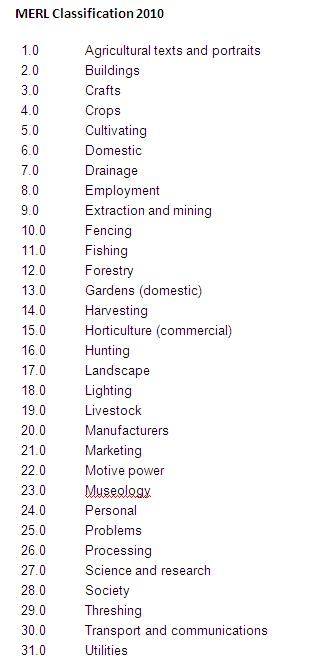Following on from my post last week about the MERL Classification and its history, I thought I would explain some of the work that we’ve been doing on it. We held Round 1 of ‘Decision Time’ (making final decisions on how to update the Classification) last week, but were a bit optimistic on how long we would need (we got about two thirds of the way through) so will have to hold Round 2 soon.
We had done quite a lot of work in preparation for ‘Decision Time’. The main issue we have with the Classification as it stands is that it contains a mixture of processes and products (things to which the processes are done). We’ve decided to separate the two out, making the Classification purely process-driven, and to have separate thesauri/vocabularies for the products, e.g. plants, animals, materials etc. This should help us apply the Classification in a more consistent and systematic way as the basis of a new subject keyword index.
The first step was to remove all the products from the Classification. Rather than coming up with our own hit-and-miss list of products, we’ve been looking for existing thesauri/vocabularies which we can draw on, such as lists of crops, trees and other plants from the MAFF Classification (Ministry of Agriculture, Fisheries and Food), Defra (Department for Environment, Food and Rural Affairs) and the Forestry Commission. We’ll hopefully be re-visiting these lists in Round 2.
The next step was to reduce the number of primary headings, making sure that they are all process-driven. Having removed the products it was then possible to start grouping existing primary headings together. For example, Drainage, Fencing and Landscape are now grouped together under a new category of Land Management; Employment, Marketing and Science & Research are now grouped together under a category relating to economics. We’re now down to 19 categories from 31.
The next step, and this is what we were concentrating on in ‘Decision Time’, was to agree on which secondary terms to include, again ensuring that they are all process-driven. This has involved moving some of the secondary headings about, grouping some of them together, re-naming some of them so that they have more of an emphasis on process, checking how many objects we have under each of them and removing those that aren’t actually being used, and thinking of other terms that we might want to add etc.
There was a lot to get through in three hours – no wonder we didn’t finish. But I have to say that ‘Decision Time’ was a lot more enjoyable than any of us had anticipated and we’re actually all looking forward to Round 2! We’ll keep you updated with how we get on.


Pingback: A Sense of Place · Nearly there with the MERL Classification